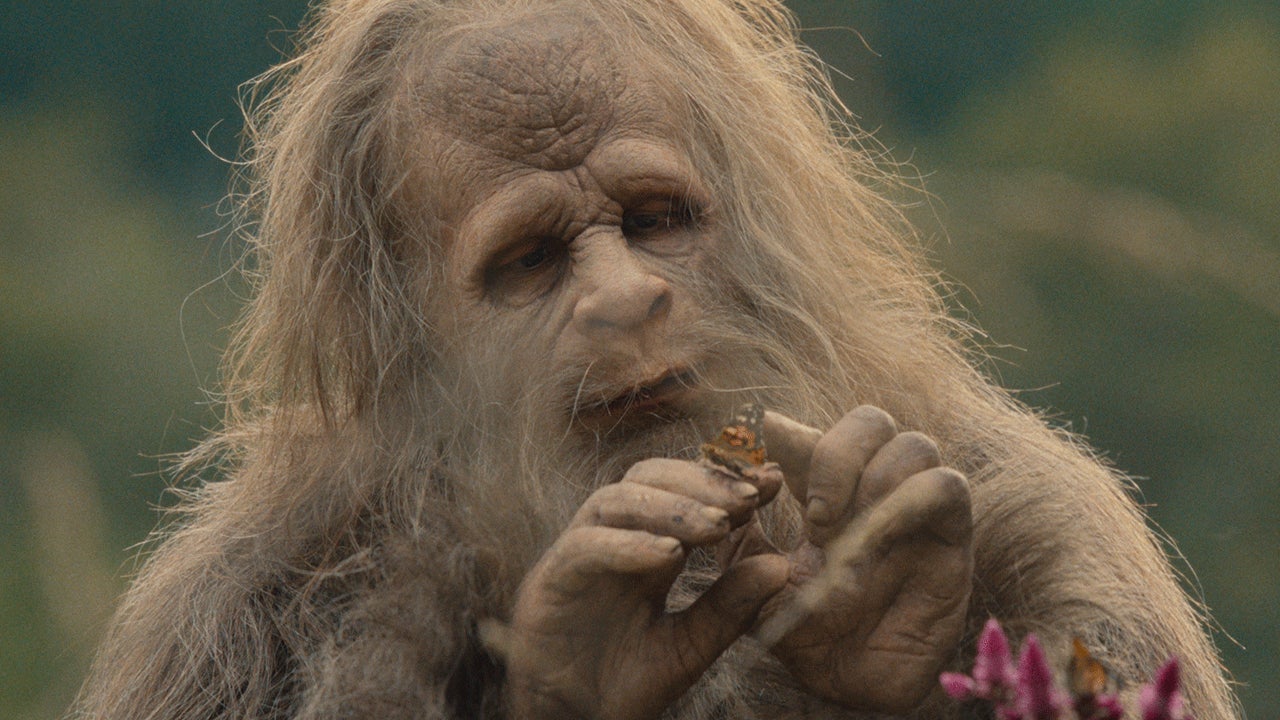Upon hearing about David and Nathan Zellner’s latest film, you may think, “Oh, to be a sasquatch, unencumbered by the weight of what it means to exist as a human.” But their beautiful and bizarre triumph, Sasquatch Sunset, would prove you wrong. The movie—which gleefully, expertly defies genre—touches on the natural joys of life, sure, but it is full of the same strife, turmoil, and emotional reckonings present in our own worlds… all presented without a lick of dialogue.
Sasquatch Sunset (review) follows a unique family of four (Nathan Zellner, Riley Keough, Jesse Eisenberg, and Christophe Zajac-Denek) over the course of one year in their lives inhabiting a vast forest covering an unidentified part of North American land. The ragtag group fights for their own survival against the increasingly inhospitable human world as it starts to seep into their natural habitat, all the while trying to confirm whether or not they are truly the last of their kind.
Naturally, it’s a creative labor to become a family in any film or theatrical setting—but when you remove spoken language and replace it with other forms of communication, it complicates everything. But the Zellners put their cast through an “ape boot camp” to help them develop a physical and non-verbal lexicon of grunts and the such that felt true to the natural core of these characters, who simply don’t have the ability to communicate in the same way humans do.
“We started by looking at a lot of primate videos and how primates talk to each other or how they communicate with their body language,” Nathan told IGN in a sit-down with the core five creatives from the film. “A lot of video, some nature docs and things that people have also captured at zoos. It's really easy to see how they interact with each other. That creates this sort of physical language within. Like [the characters’] whooping, for example, was taken from howler monkeys a little bit and how they call out to each other.” At times, folks on the creative team would be sitting in the production offices and would “just howl back and forth.”
But it’s not every project that you get to fully immerse yourself in the physicality of primate-like creatures. So Eisenberg, who was also a producer on the project, brought in a trusted movement coach, Lorin Eric Salm, to really shape the communal body language of the pack. “[Lorin] was really helpful in making sure our characters looked like they came from the same species,” Eisenberg explained. “It was great for us to be able to just codify what the movement language is.”
Salm brought the cast together as a group to mesh all of their individual work into something cohesive. “Once we started interacting with each other and figuring out what those dynamics were, that was really helpful. There was a moment where we were kind of in our own world and figuring out the walk and [things],” Keough added. “And then it was like, ‘Now how do we share food? How do we give each other things?’ And that was really helpful for me in terms of figuring out the relationship between each other and just figuring out the character more, figuring out your own place in the pack.”
Make no mistake, though: This is far from a silent story. The physical and vocal languages employed by the sasquatches quickly become very obvious and easy to follow. “The experience of watching the movie is not a silent film. It's much more like a dialogue-driven movie,” Eisenberg noted. “There's a lot of vocal [communication] and you forget that they're not speaking after a while. It just feels like they're communicating in their own way.”
That said, Sasquatch Sunset—despite, or maybe in partnership with, its plethora of gross-out hilarity—is rife with beautiful subtleties. It’s true, the movie is chock-full of sasquatch excrement, sasquatch sex, sasquatch drug trips, and a general sense of freedom and debauchery that can only come from living free of the shackles of human society. But there’s more than meets the eye here, layers upon layers that peel back the curtain on the delicate minutiae of being alive. Perhaps the example that stands out the most is the overarching focus on the eyes of our subjects, which truly become the windows to their souls.
“One of the first things I remember talking about with Nathan and David was actually watching apes eye movements and how sort of, I don't know if we're projecting what they're feeling onto them, but how powerful the eye movements of the apes were and the slow blinking,” Keough said. “They just feel like such profound creatures. That was a really early conversation [in prep].” Keough made the connection between the apes and her own dog one day during a prep meeting on Zoom, tapping into “some really expressive stuff with [the dog’s] eyes that was so subtle,” according to David.
Eyes even went on to become something of a North Star in the editing process. The Zellner brothers took point in the edit suite alongside Daniel Tarr. “When you edit normally, when there's dialogue, you're like, ‘Oh, I'll cut out this word,’ or whatever,” Nathan explained. “[For Sasquatch] we were watching a lot for when people would glance over and glance back, and the eye movement was dictating a lot of edits and how to pace the conversation between characters.” It’s a creative choice that comes through in every scene, particularly those that put Keough’s sasquatch at the forefront. What she's saying and not saying with her eyes really begets the next scene as the seasons move forward for the characters. When the camera focuses on her soft, tired gaze as the tribe’s most vulnerable nurse on her worn body, for example, the implication seems to be that the group needs her as a matriarchal figure.
But it isn’t just Keough who builds the film’s emotional core through her gaze. Each character has these moments, and it’s heart-wrenching when the cast engages these subtleties in the more tragic moments of the story. “Even thinking now, the log scene in the creek,” Nathan recalled about one of the film’s most gutting sequences. “When we talk about eyes, that whole scene, there's a lot of cutting and action and everything, but it's really the eyes that I think was why people have responded so emotionally to it.”
Zajac-Denek, who shines as the youngest sasquatch, recalled a poignant moment in the film that reinforces so much of the film’s thematic messaging within the eyes of its leads. “My favorite scene is when it's Jesse, myself, and Riley. We're all in the nest at night. Riley is kind of gazing off camera and then just her eyes move towards camera,” he told IGN. “I think that's my favorite shot in the whole film. It's really dark and you just see her eyes. I think that's so beautiful. It says a lot. There's a lot of strife and there's a lot of, ‘We're still overcoming every single minute to survive.’”
Ultimately, the group was bound to craft a closeness that would read on screen like a true bonded unit, one that didn’t necessarily need words to work. That, of course, started off-screen within the sheer uniqueness of the task at hand for these four performers.
“To me, the four of us who were playing the sasquatches were going through something very particular, just by virtue of what the parts entailed,” Eisenberg explained. “Like the costumings, we were coming in first thing in the morning and getting the makeup on for an hour. Was it two hours? We were all just going through something very particular, very physical and visceral. It just automatically lent itself to us feeling a camaraderie with each other. We were the only four people on set who understood the kind of very specific physical regimen that was required for these roles. It was physically incredibly demanding. We were trying to navigate acting while also just maintaining stamina with these incredibly made, very very beautifully rendered suits, but that also were very taxing to wear. You end up just having a shortcut to feeling a camaraderie.”
For Nathan, that sense of fellowship came when the cast first saw each other and performed in their costumes, because they had done some of their prep work without the heavy layers of makeup and prosthetics. “When you're preening and you're picking through the fur and just those kind of intimate moments with the family, we'd start holding hands and walking around, which was kind of a joke, but it gets you into character,” he said. “Because we never really say what the true dynamic is. It's like this pack mentality. There's just a hierarchy somewhat, but they're all really, really close. And you see that in the animal kingdom, like a found family.”
As the half of the directorial team who didn’t get in front of the camera, David experienced the shaping of the family from the outside looking in. “It was interesting seeing [them] all work in terms of [their] dynamic and how [they] relate to each other,” he explained. “That helped define [their] individual characteristics, and to see it all happen at the same time was really neat as people got comfortable with each other and felt more liberated through that process.”
The foundations of the film’s physical and non-verbal language—and, in turn, how the cast would build their on- and off-screen bonds through it—when David and Nathan first put pen to paper over a decade ago. “We just kind of figured it out as we went along because there wasn't a big plan; it wasn't note-carded out or anything. We'd made this short, “Sasquatch Birth Journal 2,” that just looked at what the interior lives of the sasquatch is beyond just walking around in the woods, and then almost just for fun, we started working on the script from there,” David recalled fondly. “It wasn't written like, grunt grunt, that sort of thing for dialogue. It just described the actions in as much detail as possible and especially [to set] the tone right because there wasn't an easy comp that we could refer to for a shorthand. We would try to make absolute clarity in what we were trying to do with it.”
Let’s be real: It’s been a while since something this outlandish, unconventional, and original has made its way onto the big screen—and the process of making it was just as inspired. The Zellners are beyond proud of this weird little wonder, and they’ll tell you up and down how exciting it was to create and immerse themselves in this zany world. “It was one of the most fun things I've ever written,” David gushed. “Usually I'm tearing my hair out and this one just came out. It was very, very easy.”
Like all wacky, wonderful, and heartfelt sasquatch stories should be.




